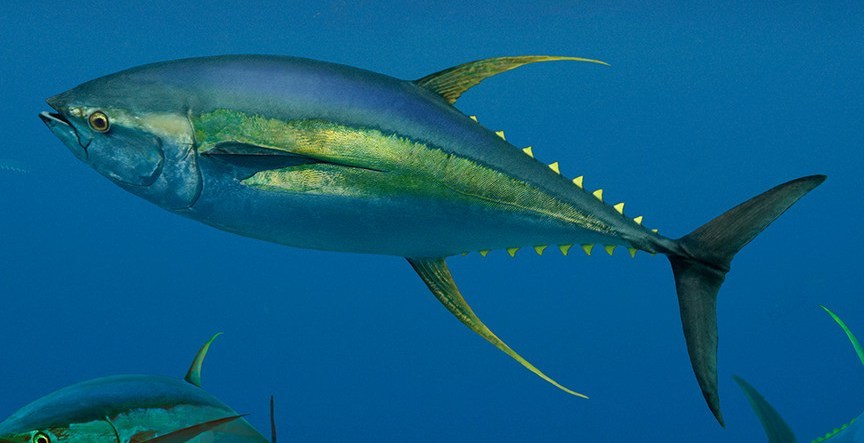Yellowfin tuna (Thunnus albacares)- one of the fastest and most valuable fish in the ocean, known for its lightning-fast swimming, bright yellow fins and important importance in the fishing industry. This type of tuna not only plays a key role in marine ecosystems, but is also an important part of the world's fisheries.
But how does yellowfin tuna differ from other tuna? How does it manage to maintain such a high speed? Why is this species under threat from overfishing? In this article, we will look at biology, lifestyle, habitat, food habits, importance for fisheries and environmental threats.

1. General characteristics and classification
Yellowfin tuna belongs to the mackerel family (Scombridae) and is one of the most common tuna species in tropical waters.
🔹 Scientific classification:
✔ The Kingdom: Animals (Animalia)
✔ Type: Chordal (Chordata)
✔ Class: Lucheperi pisces (Actinopterygii)
✔ Row: Perch-like (Perciformes)
✔ Family: Mackerel (Scombridae)
✔ Gender: Tuna (Thunnus)
✔ View: Yellowfin tuna (Thunnus albacares)
🔹 Main Features:
✔ Body lengthDimensions: 100-150 cm (up to a maximum of 240 cm).
✔ WeightWeight: 30-80 kg (sometimes up to 200 kg).
✔ Colour: metallic blue above, silver below, with bright yellow fins.
✔ Life spanAge range: 6-8 years.
✔ Swimming speed: up to 75 km/h.
Yellowfin tuna has streamlined and hydrodynamic bodythis allows it to reach high speeds, and its large crescent-shaped pectoral fins help maintain maneuverability in the water.
2. where does yellowfin tuna live?
🌍 Habitat range:
✔ Atlantic, Pacific and Indian Oceans.
✔ Caribbean, Red, Mediterranean and Arabian Seas.
✔ Waters around Australia, Japan, Hawaii, Mexico, Philippines.
🌊 Environment type:
✔ Tropical and subtropical waters (temperature 20-30°C).
✔ Habitat depth: from 1 to 250 m.
✔ Pelagic species-lives in the open ocean.
Yellowfin tuna spends most of their time in the upper layers of the oceanalthough it can sometimes dive to a depth of more than 500 m in search of prey.
3. social behavior and lifestyle
Yellowfin tuna – school fishit forms large shoals, often together with other tuna species or marine mammals.
🤝 How do they interact?
✔ Hunt co-ordinated in packs, surrounding the prey.
✔ Often accompanied by whales, dolphins and even ships.
✔ Young individuals can hide under floating objects for protection.
🏊 Speed and migrations
✔ Floating with an average speed of 10-20 km / h, but they can speed up dramatically.
✔ Travel long distances-up to 5000 km in a few months.
✔ Seasonal migrations-move in search of warm waters and food.

4. How does yellowfin tuna eat?
🍴 Basic diet:
✔ Fish - sardines, anchovies, mackerel, flying fish.
✔ Cephalopods - squid, cuttlefish.
✔ Crustaceans - krill, shrimp.
🐟 Hunting tactics:
✔ Uses strategy for surrounding schools of fish.
✔ Coordinates attacks by creating" walls " of tuna.
✔ Hunts mainly at night, using focused vision.
Yellowfin tuna it never stops, even during sleep-his body needs constant movement to provide oxygen.
5. Role in fishing and cooking
Yellowfin tuna – valuable commercial fishwhich is caught on a huge scale.
⚓ Trapping methods:
✔ Industrial Seiner Cities.
✔ Drift Cities.
✔ Fishing rods for sport fishing.
🍣 Use in cooking:
✔ Sushi and sashimi.
✔ Canned tuna.
✔ Steaks and grills.
To taste Yellowfin tuna meat It looks like bluefin tuna, but cheaper.

6. threats and environmental issues
⚠️ Main threats:
✔ Overfishing - population decline due to high fishing pressure.
✔ By-catch of sea turtles and sharks - unwanted fishing destroys ecosystems.
✔ Climate change "warming oceans are changing their habitats.
✔ Plastic and heavy metal contamination - mercury accumulates in their meat.
7. conservation measures
🌍 What do they do to protect yellowfin tuna?
✔ Install catch quotas in international waters.
✔ Use environmentally friendly fishing methods.
✔ Develop recovery farms tuna fish.
🌱 International initiatives:
✔ ICCAT monitors tuna catches in the Atlantic.
✔ The FAO promotes the implementation of ecological fishing practices.
8. Interesting facts about yellowfin tuna
✔ It can accelerate to 75 km / hwhich makes it one of the fastest fish.
✔ He doesn't have a swim bladder, so it must constantly move so as not to sink.
✔ His heart three times larger than fish of the same size - it helps to withstand loads.
✔ Yellowfin tuna can dive to a depth of up to 1000 m.
✔ It can overcome 5000 km for one migration season.
Conclusion
Yellowfin tuna is an incredibly fast, strong and important fish for both the ocean ecosystem and humans. However, overfishing threatens the future of this